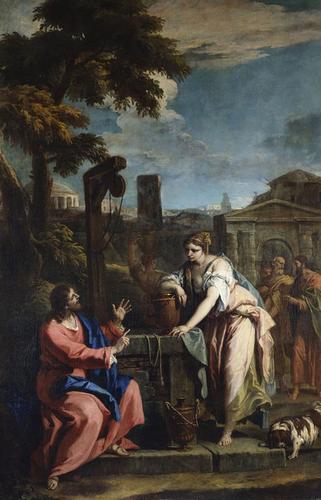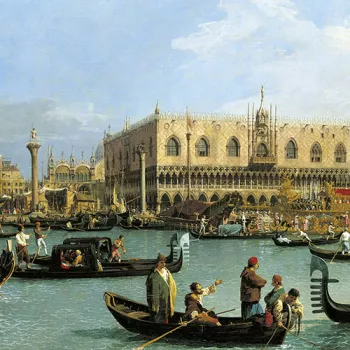Christ and the Woman of Samaria c.1724
Oil on canvas | 223.3 x 144.4 cm (support, canvas/panel/stretcher external) | RCIN 405740
-
This painting belongs to the series of seven New Testament subjects painted for Consul Smith in the 1720s. In 1742 Smith had the paintings engraved by J.M. Liotard as in his collection and they were described in 1749 in a volume published by Smith's protegé Giambattista Pasquali. The whole series shows Sebastiano's debt to Veronese, but in this work, as well as Christ and the Woman who Believed (RCIN 405739) and the Sermon on the Mount, the Roman ruins and tall trees of the landscape settings give the scenes a grandeur and gravity, recalling the seventeenth-century paintings of Claude and Poussin.
The story of Christ and the Woman of Samaria is told in John 4: 6-27. Christ is seated by Jacob's well, putsie the city of Sychar of Samaria; when a woman of Samaria comes to draw water, he asks her for a drink. She is surprised that he addresses her in public, as she is both a woman and a Samaritan. They go on to discuss the water of everlasting life. Sebastiano shows the disciples standing apart in the background, in front of the city gate. Here Christ is pictured seated at the well-head, gesticulating in conversation with the woman who rests her elbow on her water pot as she listens to him. Behind her, at the right, a group of Apostles stand before a city gate, with the city visible beyond.
One of Veronese's paintings of the subject is part of the series of ten paintings once in the collection of Archduke Leopold Wilhelm now in the Kunsthistorisches Museum, Vienna. Sebastiano is more indebted to the studio of Veronese painting (City Art Museum, St Louis, Missouri) possibly once in the church of San Zaccaria, Venice. In both Veronese versions the two protagnoists are on either side of the well, which has a winch, while the three disciples are in discussion in the background. Sebastiano borrows details from Veronese, particularly the well, in a much smaller, more intimate and contemplative treatment of the subject dated to the late 1720s (Museum of Art, Toledo, Ohio).
Six of the New Testament series are still in the Royal Collection; two are now on loan to the National Trust at Osterley House, and one is lost. It has been suggested that the series was commissioned by a member of the House of Savoy in Turin, and acquired by Smith when the commission fell through. It is more likely, however, that Smith commissioned the series himself. His ownership of sixteen preparatory drawings for the Adoration of the Magi may indicate that he was involved with the project from the outset. George Knox has outlined the way in which the series might have been hung in a single room in Smith's house in Venice, before the house was altered in the 1740s, when the series could have been displayed in two rooms.
Adapted from Canaletto & the Art of Venice, London, 2017.Provenance
Acquired in 1762 by George III from Joseph Smith, British Consul in Venice (Italian List no 30); removed from the Presence Chamber of the Lower Apartments at Kensington Palace in 1805 and recorded in the Queen's Drawing Room at Hampton Court in Pyne's Royal Residences of 1819
-
Creator(s)
Acquirer(s)
-
Medium and techniques
Oil on canvas
Measurements
223.3 x 144.4 cm (support, canvas/panel/stretcher external)
244.4 x 167.6 x 8.9 cm (frame, external)
Category
Object type(s)









